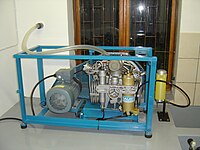
Photo from wikipedia
Abstract Compressor stations play a crucial role in natural gas networks to maintain required pressure levels for transporting gas. Centrifugal compressors commonly used in high pressure gas transmission networks could… Click to show full abstract
Abstract Compressor stations play a crucial role in natural gas networks to maintain required pressure levels for transporting gas. Centrifugal compressors commonly used in high pressure gas transmission networks could be driven by gas turbines or electric motors. Including compressor units powered via different fuels in a compressor station allows switching between fuels required by compressors to achieve a set outlet pressure and flow throughput. In this paper, an optimisation model of gas network was developed considering reasonably detailed representation of a compressor station to investigate flexibility provision from the compressor station to the power system. The model was formulated as a mixed integer linear programming (MILP) problem by linearising the nonlinear equations governing gas flow along pipes and compressor power consumption. The model was tested on the gas transmission system in South Wales, UK. The operation of compressors was optimised in response to gas and electricity price subject to meeting operational limits of the gas network. The results showed that the compressors can provide flexibility to the power system through shifting their electricity energy consumption in time or switching between gas- and electric-driven compressor units. It was found that the allowable range for variation of linepack plays a key role in the magnitude and duration of flexibility provision from compressor units.
Journal Title: Applied Energy
Year Published: 2021
Link to full text (if available)
Share on Social Media: Sign Up to like & get
recommendations!